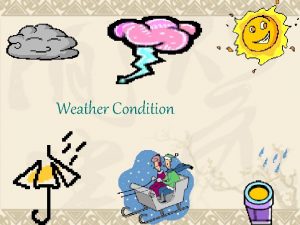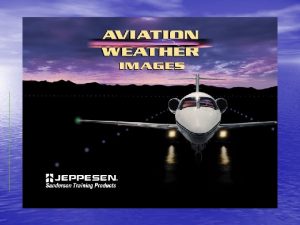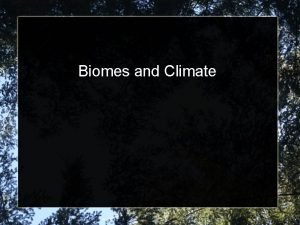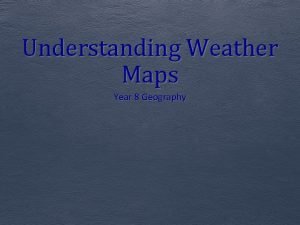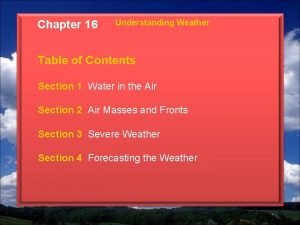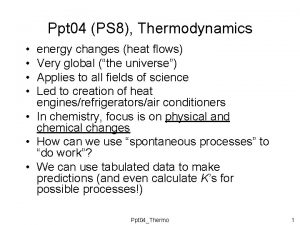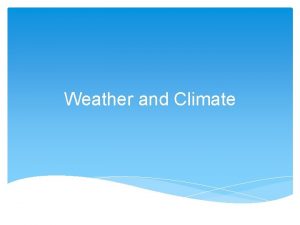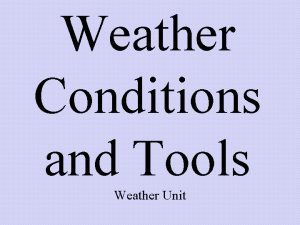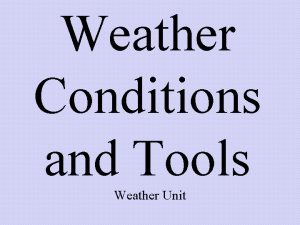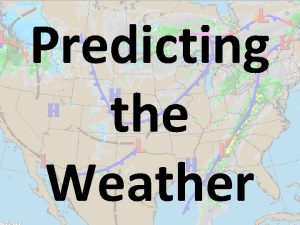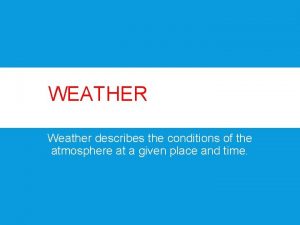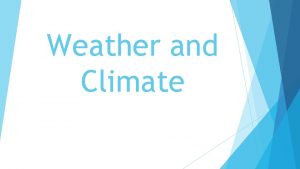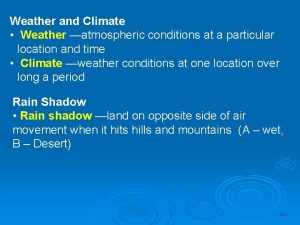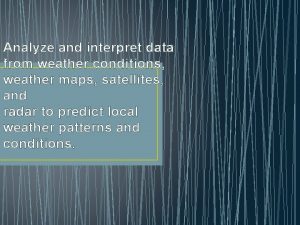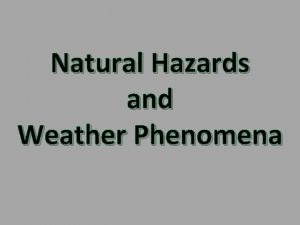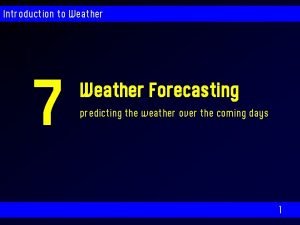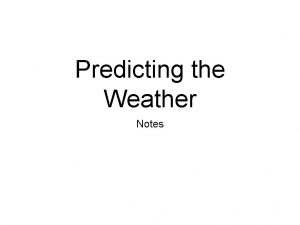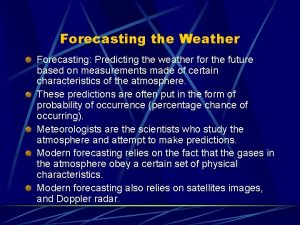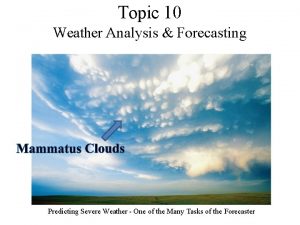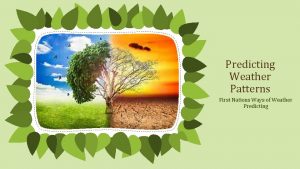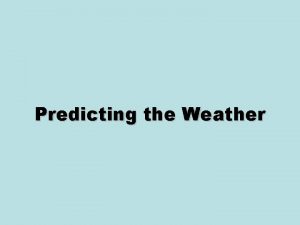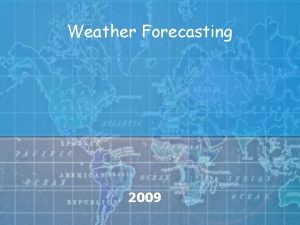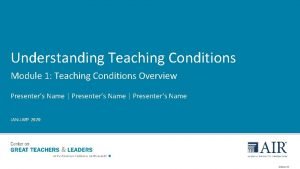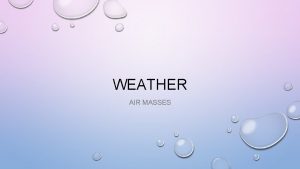Weather Understanding Predicting Weather Conditions Understanding and predicting


























- Slides: 26

Weather Understanding & Predicting Weather Conditions Understanding and predicting weather conditions

Four Elements of Weather This ELEMENT measures heat in the air This ELEMENT measures water vapor in the air This ELEMENT measures the force of air pressing down This ELEMENT measures the speed of air moving

Weather Tools Thermometer Anemometer A thermometer measures the amount of heat in the air in degrees A barometer measures the weight of the air Rain Gauge An anemometer measures the velocity or speed of air movement in miles or kilometers A rain gauge measures the levels or amount of precipitation in inches or cm. Barometer

• Wind is caused by the uneven heating of the air. • Air moves from places of high pressure to one of low pressure. • Wind is measured by an anemometer. It is measured in miles per hour. • Wind direction is determined using weather vane.

• Temperature is a measure of the amount of heat in the air. • Determined by how fast the molecules in the air are moving. The faster the molecules move, the warmer the temperature is. • Temperature is measured using a thermometer. It is measured in degrees.

Air Pressure • Refers to the weight of the air pushing down on the surface below. • LOW PRESSURE signals stormy weather. • HIIGH PRESSURE signals clear conditions.

Humidity is the measure of water vapor in the air. Water vapor is water that has evaporated after being heated Warmer climates have higher humidity. Why do you think this happens? Chances of precipitation Increase as the humidity does. Why do you think this happens? Hygrometer

Water Cycle • • • The only way that Earth can be continually supplied with fresh water. The heat from the sun is the most important part of the water cycle. This heat soaks up water from the oceans, lakes, rivers, trees and plants in a process called evaporation. As the water mixes with the air it forms water vapor. As the air cools, the water vapor forms clouds. This is called condensation. Most of the water is immediately returned to the seas by rain. The rest of the water vapor is carried inside clouds by wind over land where it rains or snows. Rain and melted snow is brought back to the oceans by rivers, streams, and run-off from glaciers and water underground. This is the process of collection. NOW IT STARTS AGAIN

• Evaporation: Evaporation is when the sun heats up water in rivers or lakes or the ocean and turns it into vapor or steam. The water vapor or steam leaves the river, lake or ocean and goes into the air. • Do plants sweat? • Well, sort of. . people perspire (sweat) and plants transpire. Transpiration is the process by which plants lose water out of their leaves. Transpiration gives evaporation a bit of a hand in getting the water vapor back up into the air.

• Condensation: Water vapor in the air • gets cold and changes back into liquid. • This is called condensation. • Precipitation: Precipitation occurs when so much water has condensed that the air cannot hold it anymore. The clouds get heavy and water falls back to the earth in the form of rain, hail, sleet or snow.

• Collection: When water falls back to earth as precipitation, it may fall back in the oceans, lakes or rivers or it may end up on land. When it ends up on land, it will either soak into the earth and become part of the “ground water” that plants and animals use to drink or it may run over the soil and collect in the oceans, lakes or rivers where the cycle starts all over again.

Precipitation Forms When snow falls it is below freezing in the upper and lower levels of the atmosphere as well as on the ground When sleet falls it is warm in the upper atmosphere, but dips below freezing near the ground forming icy pellets When rain falls warms up as the icy crystals fall from the clouds (melting them), and stays warm all the way to the ground When hail falls, it is warm at the upper levels and then turns colder. Updrafts cause water droplets to be lifted and cooled, forming chunks of ice. This can happen in a thunderstorm. or sleet


CLOUDS

Cloud Chart Cloud Group Cloud Height Cloud Types High Clouds = Cirrus Above 18, 000 feet Cirrus Cirrostratus Cirrocumulus Middle Clouds = Alto 6, 500 feet to 18, 000 feet Altostratus Altocumulus Up to 6, 500 feet Stratus Stratocumulus Nimbostratus Low Clouds = Stratus Clouds with Vertical Growth Cumulus Cumulonimbus Special Clouds Mammatus Lenticular Fog Contrails

• Most common high cloud. • Thin, feathery clouds • Associated with fair weather • Indicate rain or snow in the hours ahead

• Uniform, smooth grayish low clouds • Cover entire sky, blocking direct sunlight • resemble fog that doesn't reach the ground Thick blankets of cloud which produce light rainfall.

• Fluffy and white • Flat bottom • Form from warm, moist air rising rapidly through a cooler layer • Usually predict FAIR WEATHER until…. . they get larger and darker in the bottom

Nimbocumulus Clouds Could hold as much as 110, 000 tons of water! • THUNDERCLOUDS • Largest of all clouds • Dark, threatening clouds • Often produce thunder and lightning Can reach heights of 11 miles!

FIRST NEXT LAST THIRD

FRONTS and changing weather Boundary between two air masses of different temperature and humidity.

• storm with lightning and thunder. • produced by a cumulonimbus cloud, • usually gusty winds, • heavy rain and • sometimes hail. Needs moisture, unstable air and lift. moisture to form clouds and rain, unstable warm air that can rise rapidly. Finally… lift. from fronts, sea breezes or mountains.


Violently rotating column of air that descends from a thunderstorm. No other weather phenomenon can match the fury and destructive power of tornadoes. They can destroy large buildings and lift 20 -ton railroad cars from their tracks.


• Weather forecasting involves the observers and meteorologists and the work of machines. • Computers make forecasts more accurate, and weather satellites orbiting the earth take photographs of clouds from space. • Forecasters use these observations from ground and space, along with formulas and rules based on experience of what has happened in the past, and then make their forecast.
 Weather conditions name
Weather conditions name What does speed measure brainpop
What does speed measure brainpop Imc weather conditions
Imc weather conditions The weather conditions of a particular place
The weather conditions of a particular place The average weather conditions of a place
The average weather conditions of a place What receives the most solar radiation
What receives the most solar radiation Bahasa inggris disusun oleh
Bahasa inggris disusun oleh Apa itu previewing and predicting
Apa itu previewing and predicting The evolution of crm is reporting analyzing and predicting
The evolution of crm is reporting analyzing and predicting Di vs bis
Di vs bis Understanding weather maps
Understanding weather maps Chapter 16 section 1 water in the air answer key
Chapter 16 section 1 water in the air answer key Predicting products of chemical reactions
Predicting products of chemical reactions Predicting products of chemical reactions
Predicting products of chemical reactions More predicting products of chemical reactions
More predicting products of chemical reactions Alexandru niculescu-mizil
Alexandru niculescu-mizil Combination reaction equation
Combination reaction equation Braden scale for predicting pressure sore risk
Braden scale for predicting pressure sore risk Braden scale for predicting pressure sore risk
Braden scale for predicting pressure sore risk Predicting pip
Predicting pip Predicting pip
Predicting pip Vsepr theory is a model for predicting
Vsepr theory is a model for predicting Single replacement products
Single replacement products Predicting spontaneity
Predicting spontaneity Predicting spontaneity
Predicting spontaneity Ten ways to untwist your thinking
Ten ways to untwist your thinking Predicting spontaneity
Predicting spontaneity
